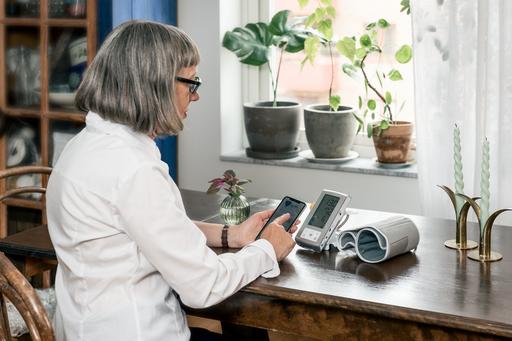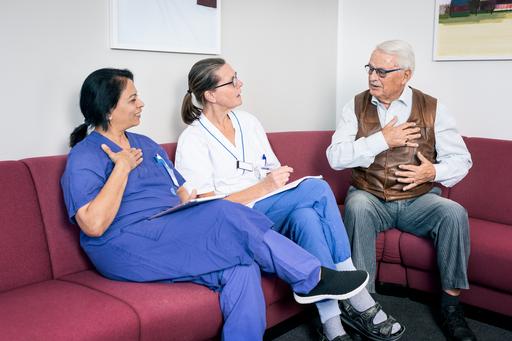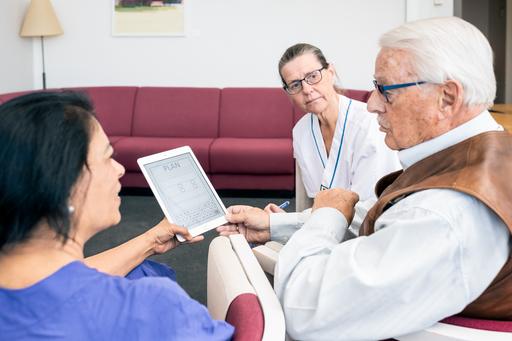- Why Person-centred care?
- What is person-centred care?
- Patient or person?
- Three key concepts: partnership, narrative and documentation
- Partnership - two experts meet
- Patient narrative - listening to the patient
- Documentation - a written health plan
- Person-centred care is climate-smart
- More information about person-centred care and person-centredness
About person-centred care
Person-centred care is a partnership between patients/relatives and healthcare professional. The starting point is to listen actively to the patient’s narrative. This, along with other examinations, forms the basis for a personal health plan.
Why Person-centred care?
We are facing a scenario of ever increasing health care costs. This is partly due to the fact that people live longer, albeit often with one or more long-term illnesses as a result. Health care today very effectively treats a multitude of solitary diseases, but lacks the over-all picture of the patient and his/her perspective, experiences, knowledge and participation. With person-centred care society’s resources can be used more effectively, as research has shown that it can reduce hospital stay, make patients feel less uncertain and reduce complications.
What is person-centred care?
Person-centredness is an ethical standpoint that guides our practical actions as fellow human beings and professionals. Person-centred care entails a partnership between patient, their relatives, and professionals, in health and elderly care and rehabilitation. Based on carefully and perceptively listening to the narrative of the patient (often combined with the narratives of their relatives) and other examinations, a health plan is co-created, containing goals and strategies for implementation, along with short and long-term follow-up.
Many professionals in healthcare claim that they already work in a person-centred manner. However, to work according to this ethical standpoint, consistently and continuously in all situations and every day, is hard. It requires an astute awareness of every independent action, good routines and working procedures, and that the wider organization is adapted for this. It requires a conscious and dedicated effort and learning, and spans far beyond a foundational value statement.
The patient is a fellow human being with abilities and needs. The qualities and abilities characterising a person can be given attention to or neglected, enhanced or diminished by others. Mutual trust between patient and healthcare professional is a prerequisite, as well as an astute awareness surrounding the asymmetry in the relationship. Professional knowledge amounts to more authority and therefore more responsibility, and this must be balanced with the patient’s right to autonomy and integrity
Patient or person?

When we talk about person-centred care, there is no conflict with the word patient. We are all patients at different times in our lives, many of us often. Nevertheless, even in these situations, we are first and foremost a person and fellow human being. At times, we want to assume a traditional patient role, and wish to focus on our illness, treatment, care, rehabilitation, and so on, but not even then do we stop being persons. At other times, our roles as parents or professionals dominate, and then our patient role gets toned down and may not be present in the picture at all. Conversely, one is always a person with abilities (and needs), aware that one is a human being and wanting to take responsibility for one’s own life. This is why we use the term person-centred care.
Three key concepts: partnership, narrative and documentation

Partnership - two experts meet
The most central aspect of person-centred care is the partnership. It involves mutual respect for each other’s knowledge and expertise; on the one hand the patient and relatives’ expertise of living with the condition, and on the other, the healthcare professional’s expertise of care, treatment, and rehabilitation of the condition - a more general knowledge.
Person-centred care entails seeing the human being behind the diagnosis; a thinking, feeling human being with experiences and knowledge, traditions and values.
Societies and human beings change and today we consider being able to decide over our own lives and bodies a human right. Person-centred care entails granting patients both rights and responsibilities concerning their own care.
Consequently healthcare has to see the patient as an active and responsible partner. This does not mean that the patient becomes a “customer”, to whom healthcare is required to deliver care entirely according to their specification. The partnership entails a mutual responsibility, and care must be adapted to suit both parties’ goals, expertise and resources.
The legal term “partnership” means that two parties agree to perform certain obligations. This agreement is consolidated in a contract. In person-centred care this contract can be translated into a personal health plan, a mutual document which ensures that care is performed as planned. The Health plan is not legally binding, but documents and describes the agreement.
In the day-to-day care environment the meeting between the patient and the professionals is fundamental to the formation of the partnership. Meetings in health care are often very brief. Health and care professionals therefore have a great responsibility to be able to acknowledge the entire person, not just the disease and clinical state of being.
Patient narrative - listening to the patient
To listen to the narrative of the patient describing their condition, combined with any results from medical examinations and tests, is a prerequisite for person-centred care. Treatment, rehabilitation, or care is planned in partnership with healthcare professionals, and an agreement is documented in the form of a written health plan, containing goals and strategies for short and long-term follow-up. Relatives often jointly take part in this process.
Narratives, written or oral can be seen as an art form. However, in everyday life we use narrative to put experiences into context. Through narratives we express our experiences and feelings so that they can be interpreted and shared with others.
The context in which the narrative is created is crucial to its content and form. The patient narrative can teach us to perceive, interpret and understand the patient’s symptoms, needs and resources – their human capacities.
A patient narrative is created through a dialogue between the patient (often together with relatives) and professionals. The dialogue can be initiated by either party, but it is the professionals’ responsibility to create the pre-conditions for and to initiate a conversation which allows for the patient’s narrative. This requires skills on the part of the professionals and must take time and may happen at more than one occasion and in connection with other activities such as assisting with meals or personal hygiene.
The focus of the narrative is the patient’s experience and interpretation of their symptoms, how these symptoms affect their daily living and what possibilities (resources) the patient has in their life. The narrative has the potential to be healing and to increase the possibilities of finding relief of symptoms.
Person-centred care research shows that the extra time required to listen and agree on a health plan is repaid many-fold in the shape of shorter total care times and higher patient satisfaction.
Documentation - a written health plan
The third component of person-centred care is the documentation of the patient narrative and health plan in the patient journal. This needs to be a living document, meaning that it must be revised on a regular basis, accessible to the patient at all times, and must follow the patient’s route through the care chain.
Information deemed necessary for a safe care is communicated within health care on a daily basis. Where possible this information may be passed on to the patient according to his/her needs and wishes. A structured and systematic documentation is necessary to ensure quality and continuity in health care.
Today documentation in health care is carried out using an IT based journal system. A condition for a person-centred perspective is that the patient’s narrative is included in their journal and that a personal health plan is created. The plan can be seen as a mutual agreement on a goal and action-plan towards improved health between care giver and patient.
It is a professional challenge to be able to document a full picture of the person’s health status using the medical record system. At GPCC we are working towards making this possible.

Person-centred care is climate-smart
Person-centred care also offers a strategy for achieving a more climate-friendly healthcare system. The World Health Organization (WHO) has long emphasized that countries must establish climate-resilient health systems to protect people’s health and avoid increasing health inequalities. According to controlled studies from GPCC, person-centred care has been shown to improve quality and optimize resource use in healthcare and social care. This not only means more efficient resource use, but also a direct reduction in energy consumption, the use of consumables, and unnecessary travel and care appointments, which in turn reduces the climate impact of healthcare.
More information about person-centred care and person-centredness
I want to learn more about person-centredness
A brief brochure about GPCC and person-centred care can be found on this page.
